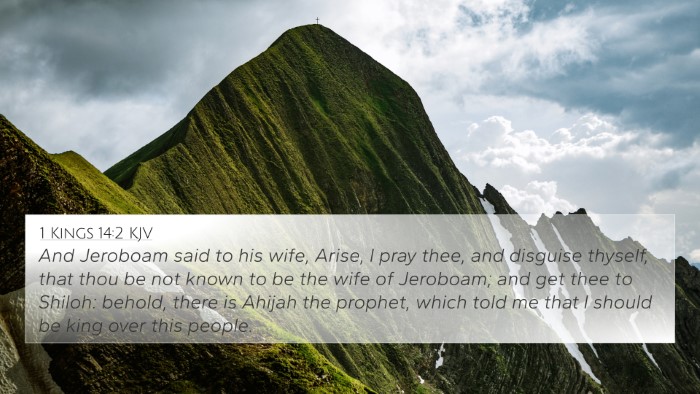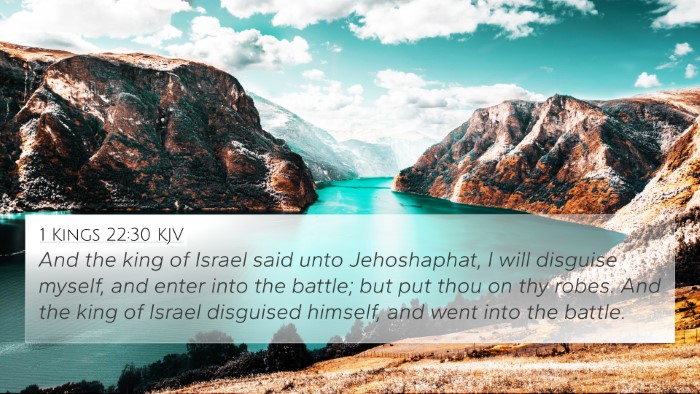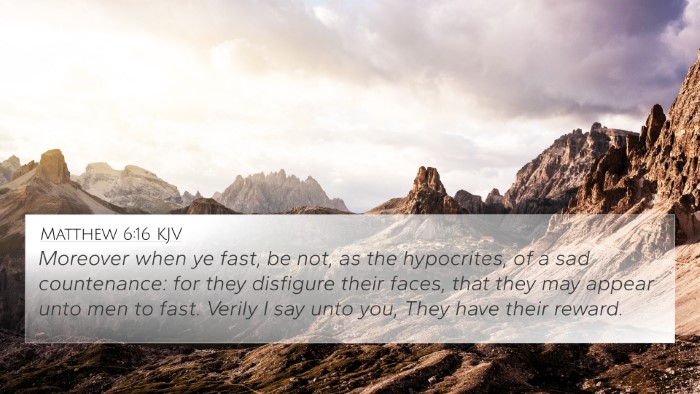Understanding 1 Kings 20:38
1 Kings 20:38 states: "So the prophet departed and waited for the king by the way; and he disguised himself with ashes upon his face." This verse presents a significant moment in the larger narrative of the conflict between the Israelites and the Syrians. The disguise of the prophet, paired with the ashes, holds deep symbolic meaning regarding truth, humility, and the seriousness of God's message.
Historical Context
This account occurs amidst tensions between Israel and Syria during Ahab’s reign. The prophet’s disguise signals an urgent message from God, illustrating the often perilous role of prophets within the historical and socio-political framework of Israel. The usage of ashes may also suggest mourning and the gravity of the situation, aligning with the broader thematic elements present in prophetic literature.
Interpretative Insights from Commentaries
Matthew Henry Commentary: Henry explains that the prophet’s actions reflect the need for discretion and wisdom in relaying God's messages. The disguise serves as a poignant reminder that prophets often approached their task with both fear and commitment, understanding people’s varied responses to divine messages.
Albert Barnes Notes: Barnes notes that the attire of ashes illustrates both an outward display of humility before the king and the internal burden the prophet carries. It enhances the gravity of his message, showcasing the importance of spiritual readiness amidst impending judgment.
Adam Clarke Commentary: Clarke emphasizes the prophetic tradition of using visual symbols as a means to convey complex divine truths. Here, the ashes could symbolize both remorse and the need for repentance, urging the king to recognize the seriousness of his decisions leading to national calamity.
Thematic Connections and Cross-References
1 Kings 20:38 connects to several important themes and verses within the Bible. Below are noted scriptural cross-references that aid in understanding this verse:
- 2 Kings 1:1-4 - Involves the theme of divine judgment and the prophetic warnings.
- Jeremiah 1:17 - Highlights the call to deliver God’s message boldly, similar to the prophet's mission in Kings.
- Ezekiel 3:17 - The theme of warning and accountability directly resonates with the prophetic duty seen here.
- Matthew 23:37 - Jesus’ lament over Jerusalem parallels the prophetic sorrow illustrated by the ashes.
- James 5:17 - Acknowledges the power of prayer and a righteous man, similar to the stature of prophets.
- Isaiah 61:1 - Discusses the anointing to preach good tidings, reflecting the prophetic mission.
- Acts 13:1-2 - The role of prophets in the early Church provides a New Testament echo of their significance.
- 1 Corinthians 14:3 - The essence of prophecy as edification aligns with this prophetic moment.
- Revelation 11:10 - The theme of prophetic witness and its societal impact resonates through biblical history.
- Hebrews 1:1-2 - References God speaking through prophets, underscoring the continuity of divine message delivery.
Conclusions and Practical Applications
The act of the prophet disguising himself can prompt a broader reflection on our readiness to share God’s truths. It invites modern readers to consider how messages are communicated. Just as the prophets of old faced significant societal pressures, contemporary believers also confront challenges when living out and sharing their faith.
This verse encourages a multi-layered examination of not only the Old Testament prophetic tradition but also invites comparisons with New Testament teachings concerning prophecy, humility, and truthfulness.
Tools for Understanding Scripture
For those interested in exploring connections between biblical texts, employing tools such as a bible concordance or a bible cross-reference guide can greatly enhance understanding when studying verses like 1 Kings 20:38. Such resources help identify thematic connections, allowing for a richer study of the interconnected nature of scripture.
Utilizing cross-referencing methods can foster a deeper insight into the overall biblical narrative and its themes, revealing the intricate tapestry of divine communication throughout history.






